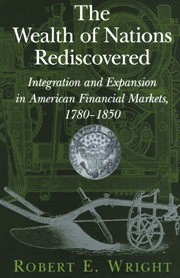 The Wealth of Nations Rediscovered
The Wealth of Nations Rediscovered Book contents
- Frontmatter
- Contents
- List of Tables
- Acknowledgments
- List of Abbreviations
- The Wealth of Nations Rediscovered
- 1 Introduction: The Wealth of Nations and National Wealth
- 2 The International and Colonial Background of America's Financial Revolution
- 3 Banks, Securities Markets, and the Reduction of Asymmetric Information
- 4 The Financial Sector and the Reduction of Lending-Related Costs and Risks
- 5 Evidence of Capital Market Integration, 1800–1850
- 6 Expansion of the Securities Services Sector, 1790–1850
- 7 The Freest of the Free: Regulation of the Financial Sector
- 8 Finance-Directed Economic Development
- 9 Conclusion
- References
- Index
2 - The International and Colonial Background of America's Financial Revolution
Published online by Cambridge University Press: 16 January 2010
- Frontmatter
- Contents
- List of Tables
- Acknowledgments
- List of Abbreviations
- The Wealth of Nations Rediscovered
- 1 Introduction: The Wealth of Nations and National Wealth
- 2 The International and Colonial Background of America's Financial Revolution
- 3 Banks, Securities Markets, and the Reduction of Asymmetric Information
- 4 The Financial Sector and the Reduction of Lending-Related Costs and Risks
- 5 Evidence of Capital Market Integration, 1800–1850
- 6 Expansion of the Securities Services Sector, 1790–1850
- 7 The Freest of the Free: Regulation of the Financial Sector
- 8 Finance-Directed Economic Development
- 9 Conclusion
- References
- Index
Summary
The premise of this book is that in the 1780s and 1790s the United States experienced a financial revolution that caused the nation's nineteenth-century growth spurt. Three important new financial innovations led that financial revolution: commercial banks, the central bank (BUS and the U.S. Treasury), and securities markets. By reducing information asymmetry and other borrowing costs and risks, commercial banks and securities markets linked borrowers to savers more efficiently than had any colonial financial arrangement. The central bank, also a new addition to the economy, kept the macroeconomy on a relatively even keel, thereby reducing systemic risk. Early U.S. savers eagerly sought financial assets because, relative to other assets, like land, they were easily exchangeable and safe. Early Americans, therefore, saved more than they would have had the financial revolution not occurred. Their savings, channeled by the banks and markets into able entrepreneurial hands, financed the “internal improvements” (infrastructure), factories, and technologies that made the United States a leading industrial power by 1865.
The U.S. financial revolution of the 1790s did not, of course, occur in a vacuum. Important precedents – foreign, imperial, and domestic – laid the necessary groundwork. First Holland and then England experienced their own financial revolutions in the seventeenth century. Additionally, colonial American courts set precedents important for financial institutions and markets when they staunchly enforced debt obligations and thereby raised the expected costs of contract breaches. Colonial governments were, in the main, financially prudent, especially after about 1750.
- Type
- Chapter
- Information
- The Wealth of Nations RediscoveredIntegration and Expansion in American Financial Markets, 1780–1850, pp. 9 - 25Publisher: Cambridge University PressPrint publication year: 2002


